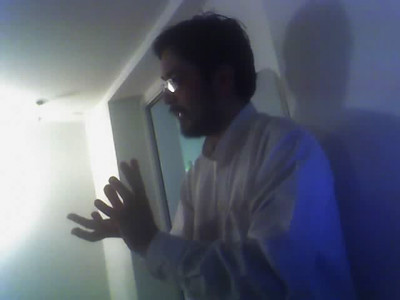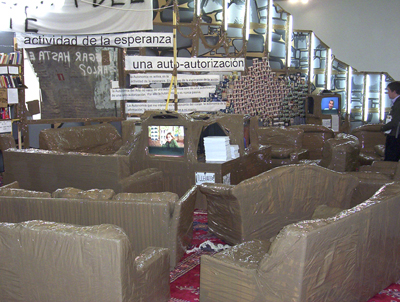Ai Weiwei

continued
Sometimes with Ai Weiwei’s work I don’t get it, but I feel it. His review show, Ai Weiwei: Under Construction at Campbelltown Arts Centre, conflated a lot of those immediate bursts of enjoyment I have with his work, because for the first time I heard him talking about things, using words in a way that made me want to think about the world with more gravity while throwing a lightness back at it. There’s three hours of footage from Fairytale in the show. In one of the earlier moments, Ai talks about the expression of the work being important from the beginning. Fairytale is such an overwhelming concept that often the idea that the artist is expressing it gets lost in the scale of human movement and human change. But the act has a form and Ai has a heart for narrative; so for the narrative to adhere there has to be a residual presence of it. A cluster of probably a hundred black and white suitcases in the first gallery at Campbelltown spelt out the collectivity of the Kassel Fairytale, how objects take on the messages of their context and can hold these messages for long enough to transmit them to an audience far away from Beijing or Kassel. (Another tiny moment of expression, in the video Ai asks if they can add mushrooms to one of the communal dishes, “mushroom goes with beef, no?”). The suitcases sit in front of group photographs of Chinese nationals swept off to Germany — there are girls winking with bright, shapeless hats on their heads and middle-aged men who look straight-up and you wonder if they sneak looks at Ai Weiwei’s blog from their desk computer during the day. A compulsion to insert narrative into Ai’s work is unrelenting …
IT’S DANGEROUS NOT TO THINK OF THE WORLD AS DANGEROUS
Template came tumbling down in a gusty storm in Kassel and Ai told the camera that it’s better because a person couldn’t do this because people don’t have the same touch as nature. He’s not an artist working in the singular. He seems to listen attentively to the world. An oily coat on a coat-hanger with a condom attached by a metal eyelet to the front has the sublimated and humorous tone of Duchamp, and the I-have-a-penis preoccupation of Wang Xiaobo. Usually artists who work with clothing have a strong sense of their personal narrative in relationship to a wider social context (Yayoi Kusama, Lucy Orta, Duchamp, Andy Warhol); an idea persists in these wearable forms that clothing is the meeting point between an internalised logic and shared logic. It can be an interesting space.
Ai’s work with wood was probably what I most wanted to see up close — I’ve always seen them as a kind of talisman or a reminder to keep looking at things and re-imagining them. Never let objects become fixed or stagnant. Always keep a flow, frenzied or gentle, keep a flow. What’s the work called? Colour Test I think. Mounds of disposed wood: some like the rocks that jutted out of water landscapes in the documentary about nature in China the other night on SBS; some with aged carvings that have been slowly worn away into gentle, cartoon-like curls. They’ve all been painted in matte and pastel colours and are gathered into a space on the ground. Not quite Stonehenge, more cognitive than cosmic. I don’t feel the nostalgia that a lot of people feel with this wood, that’s been taken from the wreckage of Hutongs. There is a pragmatism that cuts through a longing for the past — the more urgent impulse to construct a future. Dr Charles Merewether, the curator of Under Construction, refers to Ai’s work as a “history of the present”, an immediate reflection that follows any action. Again I think of a weighty understanding with light projections, perhaps to displace a trapping cycle of pessimism.
Hao Guo, James Deutsher and I flew to Campbelltown for 40 hours to see the show and go to the opening, then the conversation between Ai and Charles Merewether the next day. Sitting outside at the opening and getting fresh air, I looked down at my camera case and saw a palm-sized huntsman half on the concrete slab we were sitting on and half on my scarf. At another moment I probably would have overreacted, but Ai’s work had momentarily displaced the feeling of self being at the centre of the universe, so I enjoyed watching it walk away and negotiate a thin blade of grass.
Ai seemed tired and precise at the conversation the next day, but we waved when he sat down and he waved back (ah, connection!). The sparse audience kept on wanting him to talk about his ‘position as a Chinese artist’ when the floor was thrown open for questions, and he kept retreating in a way that made the idea of artists thinking about themselves in relationship to the ‘artworld’ kind of ridiculous. He said, “I only feel like I’m Chinese when I do things like this.”
Chinese tables and Chinese vases must translate to so many people as ways of dealing with Chinese-ness, but they’re just the objects around Ai and he is clearly responsive to social environments. Kind of flustered from the tedium of trying to remove this blanket of ‘Chinese artist’ that seemed to be smothering him on the small stage, he made his most lucid appeal, basically saying we’re humans first and that “people often see artists as someone more clear than you, but I’m just a confused man and we have to do something and we call it art.”
It’s moving work because it spreads itself out so openly, it balloons into moments of universality then retracts into personal treatments of culturally wrapped objects. (At the conversation I took notes. The first thing I wrote down was a categorical description of what Ai was wearing; everything was different shades of dark blue except for his black shoes). Charles asked about growing up as the son of displaced intellectuals — he responded by suggesting people must be punishing him by always asking about history, because he has a bad memory and doesn’t remember anything: “People are always trying to find a logical result from the past.” I guess if the past has no logical conclusion then possibilities for the future are unfettered. Nothing fixed, everything always in a state of construction.
Liv Barrett
back to SPEECH






